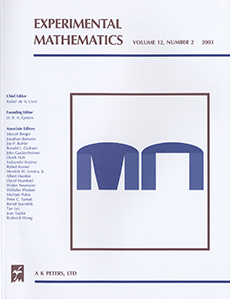Abstract
I introduce the recurrence $D(n)= D(D(n{-}1))+D(n{-}1-D(n{-}2))$, $D(1)=D(2)=1$, and study it by means of computer experiments. The definition of $D(n)$ has some similarity to that of Conway's sequence defined by $a(n)= a(a(n{-}1))+a(n-a(n{-}1))$, $a(1)=a(2)=1$. However, unlike the completely regular and predictable behaviour of $a(n)$, the $D$-numbers exhibit chaotic patterns. In its statistical properties, the $D$-sequence shows striking similarities with Hofstadter's $Q(n)$-sequence, given by $Q(n)= Q(n-Q(n{-}1))+Q(n-Q(n{-}2))$, $Q(1)=Q(2)=1$. Compared to the Hofstadter sequence, $D$ shows higher structural order. It is organized in well-defined "generations'', separated by smooth and predictable regions. The article is complemented by a study of two further recurrence relations with definitions similar to those of the $Q$-numbers. There is some evidence that the different sequences studied share a universality class.
Citation
Klaus Pinn. "A chaotic cousin of Conway's recursive sequence." Experiment. Math. 9 (1) 55 - 66, 2000.
Information




